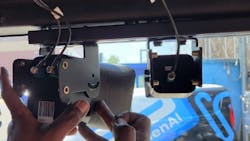New York City Uses Mobile Camera System to Catch Vehicles in Bus Lanes
The Metropolitan Transportation Authority (MTA) is mounting camera systems on the interior windshield of its buses to help it spot automobiles that block bus-only lanes.
To do so, the agency recently signed a contract to purchase 300 automated bus-lane enforcement (ABLE) systems, a mobile embedded vision technology, from Hayden AI (Oakland, CA, USA; www.hayden.ai). The authority also has an option to acquire 200 additional ABLE systems over the next 12 months. Installation of the first 300 systems is scheduled to be completed by year-end.
The goal of the program is to record license plate and other information on offending vehicles and then issue citations. “The point of fines is to get vehicles out of bus lanes,” says Eugene Resnick, Spokesperson for the MTA (New York, NY, USA; www. new.mta.info), which serves 15.3 million people in New York City and the surrounding area.
The MTA has been wrestling with how to keep buses moving in the dedicated lanes for some time. In 2019, the city launched a pilot program with Siemens Mobility (Munich, Germany; www.mobility.siemens.com), which installed camera systems on a total of three bus routes located in Manhattan and Brooklyn, according to a news release from the company. This application featured Siemens Mobility’s LaneWatch cameras, which capture the license plate details of obstructing vehicles, as well as video of location and other contextual information. In the two months after its implementation, the system detected 9,700 violations and bus speeds increased by 55%, according to Siemens.
In 2021, New York City issued more than 51,000 tickets for blocking bus lanes, which were spotted with windshield-based camera systems. In addition to those violations, the city recorded more than 551,000 additional violations in 2021 with other cameras mounted in fixed geographic locations, Resnick says.
How the Technology Works
The ABLE technology from Hayden AI is designed to achieve the same goal. It is based on a proprietary two-camera system, which is mounted on the inside windshield of a bus. The first camera records license plate information “day and night and during inclement weather,” explains Jenna Fortunati, Marketing and Communications Specialist at Hayden AI. A second camera records an 80-degree video clip showing the context of the violation, such as the make and model of the car and location and direction of travel.
The two-camera system comprises up to six proprietary low light sensors with custom image signal processing (ISP) and the NVIDIA (Santa Clara, CA, USA; www.nvidia.com/en-us/) Jetson edge computing AI platform.
Embedded software reviews the information and transfers metadata and video clips associated with a potential violation to cloud-based software. The system erases information not related to a violation. Enforcement officers can then review the information and decide whether to issue a citation.
The ABLE system is based on layers of software algorithms developed in house by a team of data scientists with expertise in computer vision and machine learning:
- A layer that analyzes video frames to identify vehicles and their relative positions.
- A mapping and policy layer in which semantic maps are embedded with a repository of applicable parking rules and regulations.
- An Inference Engine, which combines data from multiple sensors to to digitally reconstruct the event in 3D.
- A Reasoning Engine, which is capable of understanding context and severity to filter out errors.
The contract with the MTA is Hayden AI’s first revenue-generating deal, although it has completed pilot projects with other large transit agencies, Fortunati says, adding that the company expects to launch several international pilots in the fall of 2022.
About the Author
Linda Wilson
Editor in Chief
Linda Wilson joined the team at Vision Systems Design in 2022. She has more than 25 years of experience in B2B publishing and has written for numerous publications, including Modern Healthcare, InformationWeek, Computerworld, Health Data Management, and many others. Before joining VSD, she was the senior editor at Medical Laboratory Observer, a sister publication to VSD.

